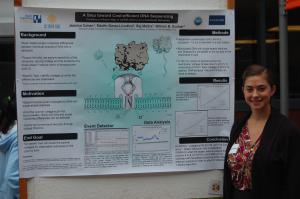Jessica Cohen: A Step toward Cost-efficient DNA Sequencing: Creating an Abasic Map of ssDNA Held in an α-hemolysin Nanopore
| Attachment | Size |
|---|---|
| 1.8 MB |
Nanopore technology is rapidly making the prospect of affordable and fast DNA sequencing a possibility. In this process, a single strand of DNA is trapped in a transmembrane pore with a voltage applied across the lipid bilayer. The current changes that occur when the strand enters the pore can be monitored and utilized to identify the sequence of the DNA.
Toward this end, I took DNA templates with a single base missing (abasic) and held them in the nanopore to observe changes in the ionic current. This information will elucidate new ways to move the DNA through the pore. One such method would involve hydrolysis on the the pore, indicated by single nucleotide shifts in the transmembrane DNA. With an abasic map demonstrating the effect of voltage and abasic site location on current, we will determine the optimal voltage such that single nucleotides can be distinguished. If successful, this would be a big step toward the exciting prospect of utilizing nanopores for DNA sequencing.
